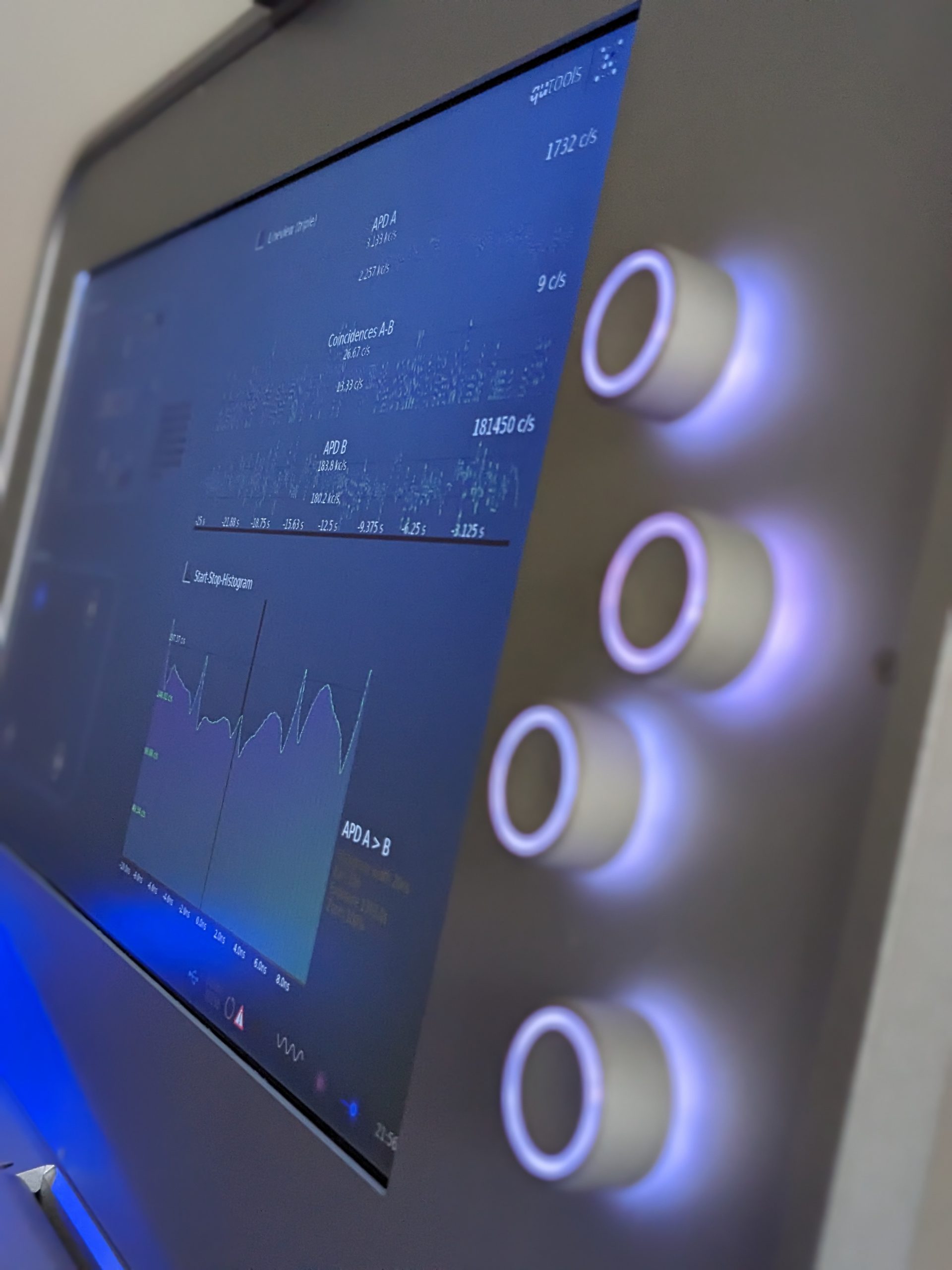The Case of Nobel Technology at UBC

Some suitcases have compartments. Others have a hard, metallic exterior to better protect its contents. But UBC has been the home to a suitcase that’s in an entirely different league.
Encased in a sleek metal shell, the shockproof Quantenkoffer is a cross between a computer, a pegboard, and the most high-tech block set. At first glance, it appears to be a blocky—albeit advanced—children’s spy playset, or perhaps a well-preserved prototype of an early laptop from the 1980s. Beneath its exterior, however, lies some of the most sophisticated and accessible technology that Quantum Physics has to show the world.

The Quantenkoffer is touted as a quantum photonics lab-in-a-box. This single standalone device is capable of replicating the experiments that earned scholars the 2022 Nobel Prize in Physics. As Geering Up’s Quantum Computing Outreach Coordinator, Ella Meyer, explains, one of the hardest parts about quantum physics is the challenge of work with it in a hands-on capacity.
“Other areas of physics have this a lot easier,” Ella explains. “For instance, if you want to talk about gravity, you can easily demonstrate it (i.e., just drop an object!). With something like quantum physics, we didn’t really have an easy way to show it. What something like the suitcase does is it takes an abstract concept and turns it into tangible building blocks. We can use lasers, easily dropped-in optical elements (mirrors, lenses, beam splitters, and etc.), and a real-time graphing display to exhibit quantum physics happening in the classroom in a way that students can engage with. Setting up an interferometer—a scientific setup that can let someone see and measure interference—on a traditional optics bench can take weeks; it takes 10 minutes to initialize the Quantenkoffer and get a working system that does the same thing.”
Essentially, the Quantenkoffer allows users to work with quantum entanglement. Since a pair of photons is inherently connected, when we use the device to alter what happens to one photon, the corresponding photon will be affected as well. Therefore, when we put the entangled photons through a polarizer, we can experiment with one and measure the effects on the other instantaneously (it’s faster than the speed of light!).
One way we can potentially apply this technology is in cryptography for quantum-secure codes.



Ella worked with fellow UBC graduate students, like Rafael Haenel and Niclas Heinsdorf, to deliver lectures on quantum physics and share hands-on experiments using the Quantenkoffer.
- April 2023—
- Seminar at the Stewart Blusson Quantum Matter Institute (QMI) for faculty, staff, and graduate students
- NSERC Quantum CREATE Research Day at the University of Victoria: Demonstrating experiments for a group of researchers, graduate students, and administrative staff.
- May 2023—
- Conducting two experiments with Geering Up’s student instructor and assistant team to measure the speed of light and demonstrate that quantum is real (the violation of Bell’s Inequality).
- UBC Science Rendezvous 2023: Giving a talk and hands-on demonstration to young learners, their families, and other attendees to get them to engage with the suitcase.
- July 2023—
- Guest lecture: Engaging with SHAD Program high school students through a live Quantenkoffer demonstration at the UBC Vancouver campus.
- Argonne National Library (Chicago, USA): Presenting experiments for QuSTEAM educators and training them on how to use the Quantenkoffer.
Ella Meyer is aware of what many people think of when she mentions the words “quantum physics.” It sounds difficult and hard to wrap one’s head around, and the term often makes people conjure up the Schrodinger’s Cat paradox.
“The thought experiment goes like this: in a closed box, you have a cat, something radioactive, and a vial of poisonous gas. If the radioactive substance decays (i.e., it emits a certain type of particle), then the vial breaks and releases the gas. Can we tell if the cat is dead or alive without opening the box?
The answer is that we simply don’t know. The cat could be dead OR alive, and until we confirm that in a measurable way (by opening the box), both outcomes are still possible. Here, many people incorrectly conclude that, if the cat could be dead or alive, then it’s BOTH (a zombie cat!). Once the box is opened, it’s suddenly absolutely alive or dead.
The truth is more subtle. When the box is closed, both futures are still possible. We can think of the cat as both alive and dead, but not some messy combination of those two states. Particles have a mathematical probability that lets them be in either state, and that gives us all the wonderful, whimsical quantum behaviours. To me, that’s much cooler than a zombie cat. Also, be nice to cats!”

“Quantum physics may seem like a scary sci-fi concept, and all the Hollywood dramatization makes it extra elusive. However, with an open mind and finding ways to engage with it directly, quantum becomes a much more tangible, real-world thing. It’s everywhere: the electricity that powers our smartphone screens utilizes quantum properties. The sun in the sky is powered by tiny interactions at a quantum level! When Olympics officials time their world records down to the millisecond, those clocks owe their accuracy to quantum,” Ella muses.
“Fundamentally, we can only understand the world when we understand how all the different parts of it work together. By being able to take on a “quantum mindset”, we get one step closer to being able to have a complete picture of the universe; how cool is that?”

And quantum physics is more accessible than ever at UBC. Geering Up offers several modes of learning for educators and students who are interested in diving deeper into quantum physics:
- Week-long summer quantum computing camps (grades 10-12) camp
- In-classroom Qubits and Bytes workshops (grades 6-7)

Join us and follow along as we GEER UP to inspire the next generations of scientists, engineers, critical thinkers, and leaders.


